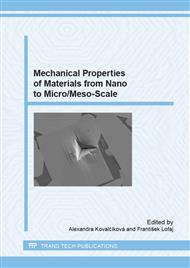p.43
p.47
p.51
p.55
p.59
p.65
p.69
p.73
p.77
Local Mechanical Characterization of Metal Foams by Nanoindentation
Abstract:
This paper deals with microstructure and micromechanical properties of two commercially available aluminium foams (Alporas and Aluhab). Since none of the materials is available in a bulk and standard mechanical testing at macro-scale is not possible the materials need to be tested at micro-scale. To obtain both elastic and plastic properties quasi-static indentation was performed with two different indenter geometries (Berkovich and spherical tips). The material phase properties were analyzed with statistical grid indentation method and micromechanical homogenization was applied to obtain effective elastic wall properties. In addition, effective inelastic properties of cell walls were identified with spherical indentation. Constitutive parameters related to elasto-plastic material with linear isotropic hardening (the yield point and tangent modulus) were directly deduced from the load–depth curves of spherical indentation tests using formulations of the representative strain and stress introduced by Tabor.
Info:
Periodical:
Pages:
59-62
Citation:
Online since:
September 2015
Authors:
Keywords:
Price:
Сopyright:
© 2015 Trans Tech Publications Ltd. All Rights Reserved
Share:
Citation:


